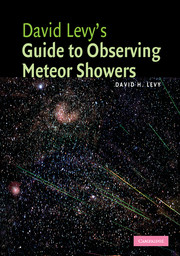Book contents
- Frontmatter
- Contents
- Preface
- 1 July 4, 1956
- 2 What is a meteor?
- 3 Some historical notes
- 4 Small rocks and dust in space
- 5 Observing meteors
- 6 Recording meteors
- 7 A New Year gift: the Quadrantids
- 8 The Lyrids – an April shower
- 9 The Eta Aquarids
- 10 The Omicron Draconids, continued
- 11 The Delta Aquarids
- 12 Tears of St. Lawrence: Perseid trails and trials
- 13 The August Pavonids
- 14 The Orionids
- 15 The Taurids
- 16 The Leonids
- 17 The Geminids
- 18 The Ursids
- 19 A catalog of meteor showers throughout the year
- Appendix
- Index
2 - What is a meteor?
Published online by Cambridge University Press: 06 July 2010
- Frontmatter
- Contents
- Preface
- 1 July 4, 1956
- 2 What is a meteor?
- 3 Some historical notes
- 4 Small rocks and dust in space
- 5 Observing meteors
- 6 Recording meteors
- 7 A New Year gift: the Quadrantids
- 8 The Lyrids – an April shower
- 9 The Eta Aquarids
- 10 The Omicron Draconids, continued
- 11 The Delta Aquarids
- 12 Tears of St. Lawrence: Perseid trails and trials
- 13 The August Pavonids
- 14 The Orionids
- 15 The Taurids
- 16 The Leonids
- 17 The Geminids
- 18 The Ursids
- 19 A catalog of meteor showers throughout the year
- Appendix
- Index
Summary
Never tell me that not one star of all
That slip from heaven at night and softly fall
Has been picked up with stones to build a wall.
Some laborer found one faded and stone cold …
A meteor is actually not an object but an event that occurs when a meteoroid, or a speck of dust, makes contact with Earth's atmosphere and heats the surrounding air to incandescence. But if the physics behind this sand-grain-sized speck of dust is complicated – its orbit around the Sun, and how it can disappear in an instant after wandering through the Solar System for billions of years – then the idea of a meteor brightening the sky for a second or two is something an inquiring child can grasp. And for that child, the first step towards understanding is to appreciate that after each meteor falls there are still just as many visible stars as there were before. Every star is a sun, in some ways like our own. These distant suns will not fall to Earth. A meteor takes place close to us, perhaps 40 miles above us in the Earth's own upper atmosphere.
So, once again: a meteor is an event that takes place when a tiny particle, called a meteoroid, enters the Earth's upper atmosphere, heating the air around it to incandescence. It is that incandescent glow that we see as a meteor. A meteoroid is the particle that produces a meteor.
- Type
- Chapter
- Information
- David Levy's Guide to Observing Meteor Showers , pp. 5 - 9Publisher: Cambridge University PressPrint publication year: 2007



